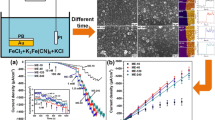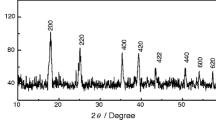Abstract
A hydrophobic room temperature ionic liquid, 1-butyl-3-methylimidazolium hexafluorophosphate ([BMIM][PF6]), was applied as nonaqueous solvent for the generation of hydroxy radical (•OH) through glucose oxidase-catalyzed Fenton reaction. The enzyme catalyzes the oxidation of glucose, and the produced H2O2 further reacts with transition metal ions, generating hydroxyl radicals. They attacked DNA and led its damage. This was detected by square wave voltammetry (SWV) of the electroactive indicator Co(bpy) 3+3 . It bound more strongly to intact DNA, and the SWV peak currents decreased at the potential of 0.064 V when DNA was damaged. The experimental results testified that the antioxidants, ascorbic acid, aloe-emodin and rutin, inhibited oxidative DNA damage by hydroxyl radicals. The method is promising for rapid, sensitive, and inexpensive detection of DNA damage.

Schematic diagram for working principle of SWV detection of in situ DNA damage for DNA-GOx film.









Similar content being viewed by others
References
Yun BH, Lee YA, Kim SK, Kuzmin V, Kolbanovskiy A, Dedon PC, Geacintov NE, Shafirovich V (2007) Photosensitized oxidative DNA damage: from Hole injection to chemical product formation and strand cleavage. J Am Chem Soc 129:9321–9332
Lee YA, Durandin A, Dedon PC, Geacintov NE, Shafirovich V (2008) Oxidation of guanine in G, GG, and GGG sequence context by aromatic pyrenyl radical cations and carbonate radical anions: relationship between kinetics and distribution of alkali-labile lesions. J Phys Chem B 112:1834–1844
Rawle RJ, Johal MS, Selassie CRD (2008) A real-time QCM-D approach to monitoring mammalian DNA damage using DNA adsorbed to a polyelectrolyte surface. Biomacromolecules 9:9–12
Zhang Y, Hu NF (2007) Cyclic voltammetric detection of chemical DNA damage induced by styrene oxide in natural dsDNA layer-by-layer films using methylene blue as electroactive probe. Electrochem Commun 9:35–41
Jin Y, Lu W, Hu JQ, Yao X, Li JH (2007) Site-specific DNA cleavage of EcoRI endounclease probed by electrochemical analysis using ferrocene capped gold nanoparticles as reporter. Electrochem Commun 9:1086–1090
Honeychurch KC, Donovan MRO, Hart JP (2007) Voltammetric behaviour of DNA based at a screen-printed carbon electrode and its application to a simple and rapid voltammetric method for the determination of oxidative damage in double stranded DNA. Biosens Bioelectron 22:2057–2064
Zhang JJ, Wang B, Li YF, Jia WL, Cui H, Wang HS (2008) Electrochemical study on DNA damage based on the direct oxidation of 8-hydroxydeoxyguanosine at an electrochemically modified glassy carbon electrode. Electroanalysis 20:1684–1689
Zhang Y, Zhang H, Hu NF (2008) Using exonuclease III to enhance electrochemical detection of natural DNA damage in layered films. Biosens Bioelectron 23:1077–1082
So M, Hvastkovs EG, Bajrami B, Schenkman JB, Rusling JF (2008) Electrochemical genotoxicity screening for arylamines bioactivated by N-acetyltransferase. Anal Chem 80:1192–1200
Feig DI, Reid TM, Loeb LA (1999) Reactive oxygen species intumorigenesis. Cancer Res 54:1890s–1894s
Ames BN, Shigenaga MK, Hagen TM (1993) Oxidants, antioxidants and the degene rative diseases of aging. Proc Natl Acad Sci USA 90:7915–7922
Riviere J, Ravanat JL, Wagner JR (2006) Ascorbate and H2O2 induced oxidative DNA damage in Jurkat cells. Free Radical Biol Med 40:2071–2079
Zu Y, Hu NF (2009) Electrochemical detection of DNA damage induced by in situ generated styrene oxide through enzyme reactions. Electrochem Commun 11:2068–2070
Zu Y, Liu HY, Zhang Y, Hu NF (2009) Electrochemical detection of in situ DNA damage with layer-by-layer films containing DNA and glucose oxidase and protection effect of catalase layers against DNA damage. Electrochim Acta 54:2706–2712
Silvester DS, He W, Aldous L, Hardacre C, Compoton RG (2008) Electrochemical reduction of benzoic acid and substituted benzoic acids in some room temperature ionic liquids. J Phys Chem C 112:12966–12972
Buzzeo MC, Klymenko OV et al (2003) Voltammetry of oxygen in the room-temperature ionic liquids 1-ethyl-3-methylimidazolium bis((trifluoromethyl)sulfonyl)imide and hexyltriethylammonium bis((trifluoromethyl)sulfonyl)imide: one electron reduction to from superoxide steady-state and transient behavior in the same cyclic voltammogram resulting from widely different diffusion coefficients of oxygen and superoxide. J Phys Chem A 107:8872–8878
Hu YL, Lu Y, Zhou GJ, Xia XH (2008) A simple electrochemical method for the determination of hydroxyl free radical without separation process. Talanta 74:760–765
Pang DW, Abruna HD (1998) Micromethod for the investigation of the interactions between DNA and redox-active molecules. Anal Chem 70:3162–3169
Zhou LP, Yang J, Estavillo C, Stuart JD, Schenkman JB, Rusling JF (2003) Toxicity screening by electrochemical detection of DNA damage by metabolites generated in ultrathin DNA-enzyme films. J Am Chem Soc 125:1431–1436
Huang JY, Li T, Chen ZY, Liu XJ, Liu SL (2008) Rapid electrochemical detection of DNA damage and repair with epigallocatechin gallate, chlorogenic acid and ascorbic acid. Electrochem Commun 10:1198–1205
Liu Y, Hu NF (2007) Loading/release behavior of (chitosan/DNA)n layer-by-layer films toward negatively charged anthraquinone and its application in electrochemical detection of natural DNA damage. Biosens Bioelectron 23:661–667
Qiu YY, Qu XJ, Dong J, Ai SY, Han RX (2011) Electrochemical detection of DNA damage induced by acrylamide and its metabolite at the grapheme-ionic liquid-Nafion modified pyrolytic graphite electrode. J Hazard Mater 190:480
Huang JL, Yang GJ, Meng WJ, Wu LP, Zhu AP, Jiao XA (2010) An electrochemical impedimetric immunosensor for label-free detection of camphylobacter jejuni in diarrhea patients’stool based on O-carboxymethyl chitosan surface modified Fe3O4 nanoparticles. Biosens Bioelectron 25:1204–1211
Maezono T, Tokumura M, Sekine M, Kawase Y (2011) Hydroxyl radical concentration profile in photo-Fenton oxidation process: Generation and consumption of hydroxyl radicals during the discoloration of azo-dye Orange II. Chemosphere 82:1422
Tokumura M, Morito R, Hatayama R, Kawase Y (2011) Iron redox cycling in hydroxyl radical generation during the photo-Fenton oxidative degradation: dynamic change of hydroxyl radical concentration. Appl Catal B: Environ 106:565
Amos M, James R (2006) Studies of DNA damage inhibition by dietary antioxidants using metallopolyion/DNA sensors. Electroanalysis 18:327–332
Xiong HY, Wang Y, Zhang XH, Ye Y, Wang SF (2011) Evaluation of antioxidative capacity via measurement of the damage of DNA using an electrochemical biosensor and an ionic liquid solvent. Microchim Acta. doi:10.1007/s00604-011-0739-4
Lee HZ, Lin CJ, Yang WH, Leung WC, Chang SP (2006) Aloe-emodin induced DNA damage through generation of reactive oxygen species in human lung carcinome cells. Cancer Lett 239:55–63
Tian B, Hua YJ (2005) Concentration depedence of prooxidant and antioxidant effects of aloin and aloe-emodin on DNA. Food Chem 91:413–418
Tian X, Li FJ, Zhu L, Ye BX (2008) Study on the electrochemical behavior of anticancer herbal drug rutin and its interaction with DNA. J Electroanal Chem 62:1–6
He JB, Wang Y, Deng N, Lin XQ (2007) Study of the adsorption and oxidation of antioxidant rutin by cyclic voltammetry-voltab sorptometry. Bioelectrochemistry 71:157–162
Acknowledgements
This work was supported by the National Natural Science Foundation of China (No. 20875023),the Natural Science Fund for Creative Research Groups of Hubei Province of China (No. 2011CDA111) and the Foundation of the Key Laboratory of Analytical Chemistry for Biology and Medicine (Wuhan University), Ministry of Education (No. ACBM2010001).
Author information
Authors and Affiliations
Corresponding author
Rights and permissions
About this article
Cite this article
Chen, Y., Xiong, H., Zhang, X. et al. Electrochemical detection of in situ DNA damage induced by enzyme-catalyzed Fenton reaction. Part II in hydrophobic room temperature ionic liquid. Microchim Acta 178, 45–51 (2012). https://doi.org/10.1007/s00604-012-0809-2
Received:
Accepted:
Published:
Issue Date:
DOI: https://doi.org/10.1007/s00604-012-0809-2




